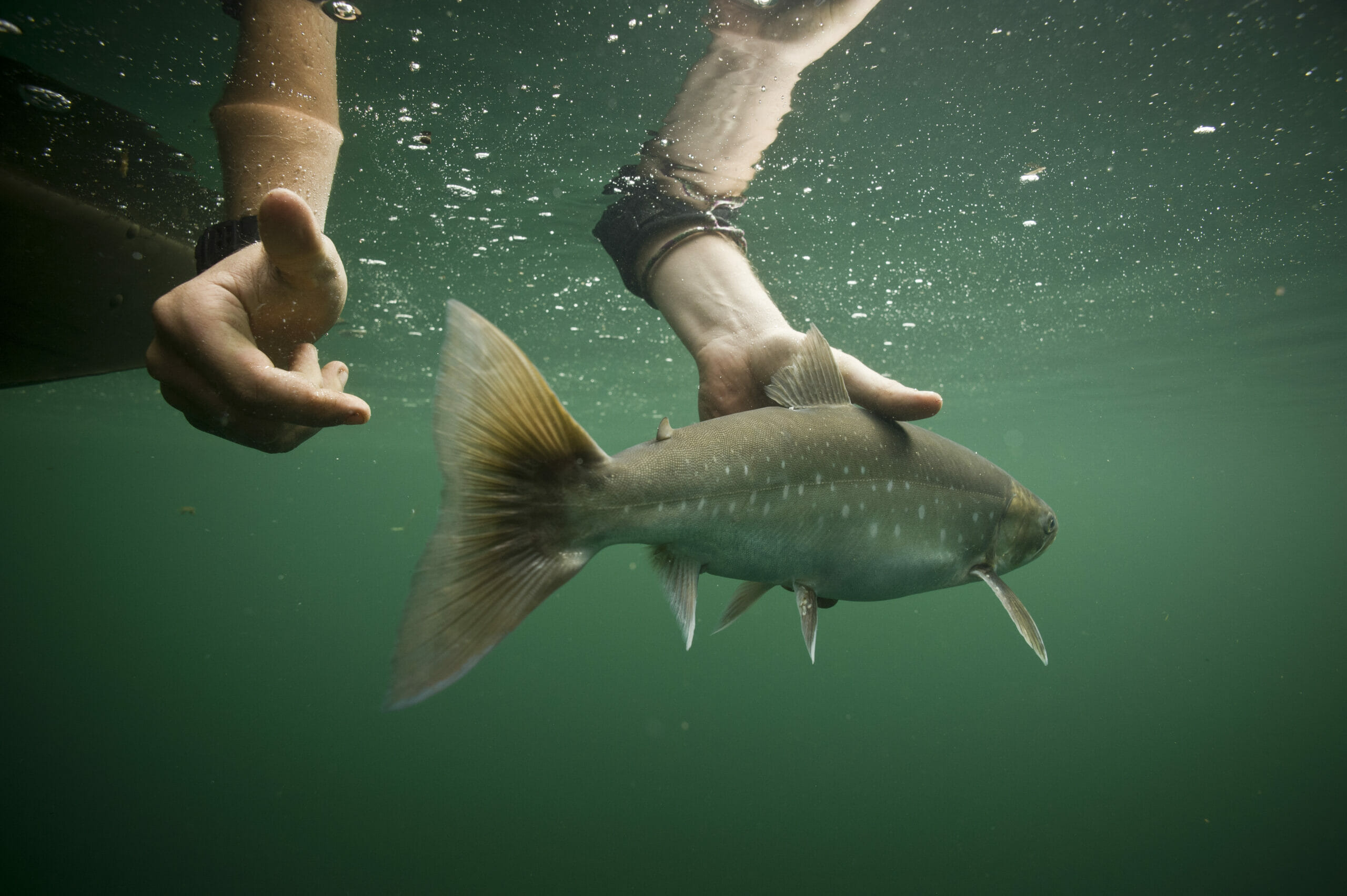Tim Romano photo.
Arctic Char (Salvelinus alpinus)
Species status and summary: In Alaska, Arctic char are often confused with a closely related species, Salvelinus malma (Dolly Varden), since Dolly Varden have similar coloration and inhabit the same locations as Arctic char. In many cases, definitively distinguishing Arctic char from a Dolly Varden requires close examination of several body structures. Generally speaking however, Arctic char tend to have fewer and larger spots, a more deeply-forked tail, and a narrower caudal peduncle (the area before the tail fin) than Dolly Varden. Spawning Arctic char are usually gold, orange, yellow or rosé and only infrequently red, while spawning Dolly Varden are usually red or pink on the lower abdomen with bright red spots. Spawning male Arctic char also have a much smaller kype (hooked lower jaw) than spawning male Dolly Varden.
Arctic char are highly variable in color depending on environmental conditions within their lake of residence and time of year, but are generally brown to greenish-brown on their upper body and lighter on their lower body. They have sparse pink to red spots on their back and sides (15-20 below their lateral line) and typically, the leading edge of their lower fins are white. In spawning adults, especially males, the lower body and the lower fins are orange to red, with fins having a prominent white leading edge. Spawning colors are more exaggerated in males than in females.
Little is known about the life history of Arctic char in Alaska lakes. However, in other areas, char often exist in two different forms in the same lake. These forms are usually described as “dwarf” and “normal.” The forms show differences in habitat and food selection, resulting in different growth rates, size at maturity, and average size. Growth is slow for Arctic char in Alaska’s cold, often nutrient-poor lakes. Arctic char have been known to live for over 20 years. Maximum size may vary greatly, depending on the productivity of the particular lake and the presence of other fish species. Fish over 10 pounds are not uncommon in some Alaska lakes, while other lakes may not produce fish over two pounds even though fish may reach great age. The largest Arctic char in Alaska probably occur in some of Bristol Bay’s large lakes, where good fishing can be had from late May through early July when these fish congregate to feed on salmon smolts as they move toward the sea.
Spawning takes place in lakes between the fall months of August and October.
Arctic char are found in lakes in the Brooks Range, the Kigluaik Mountains, the Kuskokwim Mountains, the Alaska Peninsula, Kenai Peninsula, Kodiak Island, and in a small area of Interior Alaska near Denali Park.
Looking Forward: Populations of Arctic char in Alaska are considered to be relatively stable throughout their range in Alaska due to their relative isolation (lakes only) and a very conservative management regime adopted by the Board of Fisheries that results in relatively low harvest rates. Wild Arctic char populations in Alaska generally are healthy and lightly fished, and there are currently no special sport or subsistence harvest regulations for Arctic char. It is believed that all fisheries of wild populations are stable and support current levels of harvest. Most sport fisheries targeting Arctic char are on sterile, hatchery reared fish stocked in lakes and ponds along the road system and these fish are not addressed here
Potential threats to northern char populations include over-harvesting, habitat degradation/disruption, climate change, invasive species, and pollution among others. In Alaska, where Arctic char occur only in lakes and where management regulations are fairly conservative, overharvesting is a relatively small concern at present. Given that large portions of Alaska’s Arctic char habitat remains intact and is relatively remote, perhaps the most urgent threat is climate change which is predicted to exacerbate existing stressors (ACIA 2005; Reist et al. 2006a). For example, rising temperatures may increase the level of contaminants, such as mercury, in Arctic freshwaters negatively affecting the health of the fish and the ecosystems they inhabit (ACIA 2005; Reist et al. 2006b).
Climate change in the Arctic may pose the largest threat for freshwater fishes. Alaska’s Arctic environment is projected to experience a rise in temperature of approximately 44 degrees by 2100. The magnitude of change is imprecisely known, but global circulation models identify Alaska as one of the fastest warming regions of the planet (Martin et al. 2009). Annual precipitation is also expected to increase, although there is less certainty surrounding this prediction.
All data compiled from:



